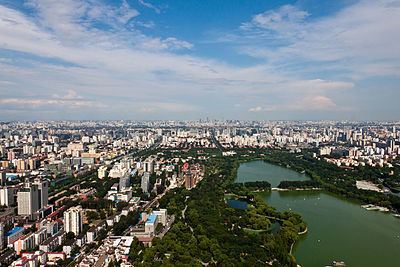Time zone China Standard (UTC+8) Website bjhd.gov.cn Population 3.281 million (2010) Municipality Beijing | Postal code 100080 Area 431 km² Area code 0010 | |
 | ||
Country People's Republic of China Township-level divisions 22 subdistricts
5 towns
2 townships Colleges and Universities Tsinghua University, Peking University, Renmin University of China, Beihang University, Beijing Normal University Points of interest Summer Palace, Fragrant Hills Park, Old Summer Palace, Beijing Botanical Garden, Tsinghua Garden | ||
Haidian District (simplified Chinese: 海淀区; traditional Chinese: 海淀區) is a district of the municipality of Beijing. It lies towards the northwestern part of the urban core.
Contents
- Map of Haidian Beijing China
- Sister cities
- Administrative division
- History
- Transportation
- Metro
- Government and infrastructure
- Economy
- Higher education
- Primary and secondary education
- Communities
- Sports
- References
Map of Haidian, Beijing, China
It is 431 square km in area, making it the second-largest district in urban Beijing (after Chaoyang), and is home to 2,240,124 inhabitants (2000 Census); however, in comparison to other districts, a higher percentage of its inhabitants do not have the governmental residential certificates for long-term residence, because Haidian District is where most universities are located and therefore many of its inhabitants are college students.
Sister cities
Since 1992, Haidian District has signed official papers and established Sister City relationship with 14 cities and districts from 10 countries of 4 continents. Some sister cities are shown below:
South America
North America
Europe
East Asia
Administrative division
The administrative division of the district was reported as follows:
History
Haidian was originally a village outside of Beijing's Inner City. It was first built in the Yuan Dynasty and became one of the eight major business areas of the capital during the Qing Dynasty and was the seat of such old shops as Lotus White, Quanjude and Hongbin House. The famed Old Summer Palace and Summer Palace, two grand imperial gardens are also among its reputed features. It became a university district after the building of the Tsinghua University and Yenching University campus in the early twentieth century. It is mentioned in Lao She's novel Camel Xiangzi as an academic village for students. After the foundation of the People's Republic, it was deliberately developed as a university area, with many of the Yan'an institutions moving there. It officially became an administrative district in June 1954. Since the reform and opening up, it has become the centre of China's IT industry. In the words of Time magazine:
During the later half of the 1990s, out of the Beijing districts, Haidian had the highest per capita GDP. During that period the GDP of Haidian (1) District grew by double digits each year.
Transportation
The northwestern stretches of the 3rd Ring Road, 4th Ring Road and 5th Ring Road all run through the area.
Metro
Haidian is currently served by nine metro lines operated by Beijing Subway and one commuter line operated by BCR:
Government and infrastructure
The China National Space Administration has its headquarters in the district.
Economy
A central part of Haidian's economy, the Zhongguancun electronics district, hosts the Beijing offices of many software and computer-technology companies.
Higher education
Institutions of higher education in Haidian include:
Primary and secondary education
The Beijing Municipal Commission of Education (simplified Chinese: 北京市教育委员会; traditional Chinese: 北京市教育委員會; pinyin: Běijīng Shì Jiàoyùwěiyuánhuì), the local education authority, has its headquarters in the Beijing Olympic Building.
Institutions of secondary education include:
Private schools include:
Communities
Sports
The Chinese Ice Hockey Association, which governs ice hockey and bandy in China, has its offices at 56, Zhongguacun South Street in Haidian District.
